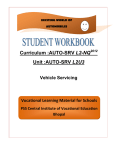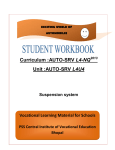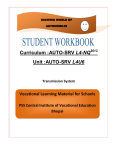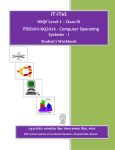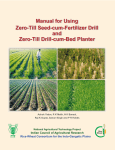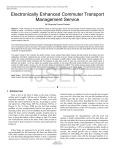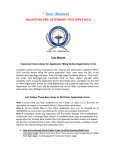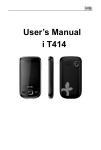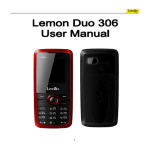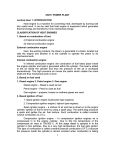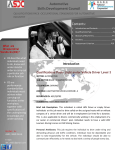Download 8 - Psscive
Transcript
g EXCITING WORLD OF AUTOMOBILES Curriculum : AUTO-SRV L3-NQ2012 Unit :AUTO-SRV L3U1 Regular maintenance of an engine Vocational Learning Material for Schools PSS Central Institute of Vocational Education Bhopal AutoL3U1-NQ2012 Regular maintenance of an engine PREFACE Improving the parity of esteem between the general academic education and vocational education, is the policy priority of the Government of India. The National Vocational Education Qualification Framework (NVEQF) developed by the Ministry of Human Resource Development (MHRD), Government of India, is a descriptive framework that provides a common reference for linking various qualifications. It will be used for setting common principles and guidelines for a nationally recognized qualification system covering Schools, Vocational Education and Training Institutions, Technical Education Institutions, Colleges and Universities. The NVEQF will act as a translation device to make qualifications more understandable to employers, students and institutions. It will promote transparency of qualifications and facilitate learner’s mobility between different qualifications, thus encouraging lifelong learning. PSSCIVE has taken lead in development of learning material for the Automobile Sector for all level in collaboration with the Automobile Skill Development Corporation (ASDC). The present material contains activity related to Level L-3 for the Automobile service sector. This will fulfill the needs of the students willing to learn activities relating to the Automobile Service Sector. Any student/ entrepreneur willing to start an Automobile Service Sector can acquire the desired competencies with the help of this book. The book has been written by experts but reviewed by all the members of the group. I am grateful to the authors for the development of this book and to the members of the Working Group for their candid suggestions, during the development and review. Their names are given elsewhere. I appreciate efforts put in the by Dr. Saurabh Prakash, as the Project Coordinator of the Working Group in planning and organizing Meetings which led to the final form of this title. I shall be grateful to receive suggestions and observations from readers, which would help in bringing out a revised and improved version of this book. Bhopal June, 2012 Prof. R.B. Shivagunde Joint Director Pandit Sunderlal Sharma Central Institute of Vocational Education 2 AutoL3U1-NQ2012 Regular maintenance of an engine 3 AutoL3U1-NQ2012 Regular maintenance of an engine © Ministry of Human Resource Development 2012 Copyright protects this publication. Except for purposes permitted by the Copyright Act, reproduction, adaptation, electronic storage and communication to the public are prohibited without prior written permission. This student workbook was developed, with active involvement of the Automobile Skill Development Council (ASDC), keeping in view the National Occupation Standard (NOS) for Service Technicians L4 developed by ASDC. This project for development of the student workbook was coordinated by the PSS Central Institute of Vocational Education, a constituent unit of National Council of Educational Research and Training, which is under the Ministry of Human Resource Development, Government of India. 4 AutoL3U1-NQ2012 Regular maintenance of an engine Student Details Student Name: _____________________________ Student Roll Number:________________________ Batch Start Date: __________________________ 5 AutoL3U1-NQ2012 Regular maintenance of an engine Contents About this workbook………………………………………….…………. 6 Unit information…………….……………………………….…………… 7 Elements and performance criteria…..………….…………………… 8 Relevant knowledge and skills…………….……………………….… 10 Assessment plan……………………………………………...………… 10 Introduction……………………………………………….……………… 12 Session 1: Inspection of an engine…. …………….……………… 13 Relevant Knowledge:…………………………………………………… 13 Exercise……………………………….………………………………… 16 Assessment Activities …………………………………………………… 16 Checklist for Assessment Activities…………………………………… 16 Session 2: Washing of an engine…….. …………………………… 18 Relevant Knowledge:…………………………………………………… 18 Exercise……………………………….………………………………… 19 Assessment Activities …………………………………………………… 20 Checklist for Assessment Activities…………………………………… 20 Session 3: Tuning fuel system of an engine …………………………… 21 Relevant Knowledge. …………………………………………………… 21 Exercise…………………………………………………………………… 23 Assessment Activities……………………………….….……………….. 23 Checklist for Assessment Activities……………………………………. 23 Session 4: Tuning of an ignition system of engine …………………… 25 Relevant Knowledge. …………………………………………………… 25 Exercise……………………………………………………...…………… 26 Assessment Activities…………………………...…….………………… 27 Checklist for Assessment Activities…………………………………… 27 Session 5: Tuning of engine lubrication system …………………… 28 Relevant Knowledge. …………………………………………………… 28 Exercise……………………………………………………...…………… 29 Assessment Activities…………………………...…….………………… 30 Checklist for Assessment Activities…………………………………… 30 Session 6: Tuning of engine cooling system ………………………… 32 6 AutoL3U1-NQ2012 Regular maintenance of an engine Relevant Knowledge. …………………………………………………… 32 Exercise……………………………………………………...…………… 34 Assessment Activities…………………………...…….………………… 34 Checklist for Assessment Activities……………………………………. 35 Session 7: Tightening of fastener (Nuts/Bolts/Screws)………………… 36 Relevant Knowledge.. …………………………………………………… 36 Exercise……………………………………………………...…………… 37 Assessment Activities…………………………...…….………………… 38 Checklist for Assessment Activities……………………………………. 38 Session 8: Engine Timing (Tuning) ………..………………………… 40 Relevant Knowledge. …………………………………………………… 40 Exercise……………………………………………………...…………… 42 Assessment Activities…………………………...…….………………… 42 Checklist for Assessment Activities……………………………………. 42 Suggested Readings……………………..……………………………… 44 Contributors to the Workbook Development ………………………… 45 7 AutoL3U1-NQ2012 Regular maintenance of an engine About this Workbook This workbook is to assist students with completing the Auto Sector L3U1NQ2012 unit of competency: Regular maintenance of an engine. Students should peruse the workbook in class or in their own time. This workbook contains sessions for imparting knowledge & skills on various basic aspects of the unit of competency. The workbook also includes information, exercises and assessment activities to complete. The assessment plan has been included in the workbook to assist you in scheduling your time for completing the assignments. Each assessment activity is followed by a checklist for meeting the assessment criteria. The criteria will help you to ensure that you have fulfilled all of the assessment requirements to receive a ’competency’ grading/Certification by ASDC. 8 AutoL3U1-NQ2012 Regular maintenance of an engine Unit Information Unit name: Regular maintenance of an engine Unit code: Auto L3U1-NQ2012 Unit descriptor: This unit provides introductory knowledge & skills covering vehicle servicing, specially for engine of a four wheeler. Students will be given a broad view of these important issues. Resources required: • Notebooks, Pen, Pencil, Eraser, • Computer, Open Source Software for making digital presentation, • LCD projector. • Sketches, pictures, animation and videos of engine of automobiles and its components. • Posters for building awareness about these topics. Nominal hours: 80 Periods 9 AutoL3U1-NQ2012 Regular maintenance of an engine Elements and Performance Criteria • Elements define the critical learning outcomes of a unit of competency. • Performance criteria specify the level of performance required to demonstrate the achievement of the Competency Element. Element of knowledge Inspection of an engine Washing of a engine Tuning fuel system of an engine Tuning of an ignition system of an engine Performance Criteria • Able to trace different leakages like those of oil, coolant and combustion gases • Able to wash an engine externally • Able to handle the washing equipment • Able to follow appropriate precautions • Able to trace the fuel system in a given vehicle engine • Able to check the fuel line for leakage • Able to conduct fuel pump test and compare its reading with the service manual • Able to set carburetor for ideal speed • Able to test nozzle for pressure • Able to trace the primary and secondary circuit(s) • Check the terminals for loose connection. • Able to clean spark plug and distributor 10 AutoL3U1-NQ2012 Regular maintenance of an engine Tuning engine lubrication system • Able to check the level and quality of lubricating oil • Able to replace the oil and change the oil filter • Able to check the oil pressure Tuning of engine cooling system • Able to read the temperature gauge • Able to check circulation of water in cooling system • Able to trace for coolant leakage Tightening of fastener • Able to tight fasteners with specified (Nuts/Bolts/Screws) torque and with sequence in the following components; cylinder head, induction manifold, Exhaust manifold and • engine foundation nuts and bolt . Engine Timing • Able to understand importance of engine timing • Able to feel the sound change after tuning process 11 AutoL3U1-NQ2012 Regular maintenance of an engine Relevant Knowledge and Skills 1. Relevant Knowledge • • • • • • • • 2. Inspection of an engine Washing of an engine Tuning fuel system of an engine Tuning of the an ignition system of an engine Tuning of the engine lubrication system Tuning of the engine cooling system Tightening of fastener (Nuts/Bolts/Screws) Engine Timing Skills Able to do the following tasks in a vehicle • • • • • • • • • • • • • • Able to trace different leakages like oil, coolant and combustion gases Able to wash an engine externally Able to handle the washing equipment Able to follow appropriate precautions Able to trace fuel system in a given vehicle engine Able to check the fuel line for leakages Able to conduct fuel pump test and compare its reading with service manual Able to set carburetor for ideal speed Able to test nozzle for pressure Able to trace the primary and secondary circuit(s) Check the terminals for loose connection. Able to clean the spark plug and distributor Able to check the level and quality of lubricating oil Able to replace the oil and change the oil filter 12 AutoL3U1-NQ2012 Regular maintenance of an engine • • • • • • • Able to check the oil pressure Able to read temperature gauge Able to check circulation of water in cooling system Able to trace for coolant leakage Able to tight fasteners with specified torque and with sequence in the following components; cylinder head, induction manifold, Exhaust manifold and engine foundation nuts and bolt Able to understand importance of engine timing Able to feel the change in sound after tuning Assessment Plan Session No. 1. 2. 3. Assessment method Due Date Completion Date Fill in the Blanks Fill in the Blanks Fill in the Blanks 13 AutoL3U1-NQ2012 Regular maintenance of an engine Introduction Driving a car can be fun, but its maintenance can be a pain. No one really enjoys the task of automobile maintenance. As long as the automobile works fine, we are happy and don't always remember to get its maintenance of done. Even if your vehicle works fine, getting its servicing and maintenance of regularly is necessary. General vehicle maintenance helps to keep it in good condition and can save your trouble of repairing or changing its major parts in the long run. Regular oil check and change is required and can be considered as one of the most important steps to maintain your car. Vehicle owners never keeps track of when their engine needs an oil change. Old oil or insufficient oil in your engine will heat up the engine quickly and might lead to damage and other problems in your vehicle. To fix these problems you will have to pay quite a lot. To keep your automobile running efficiently and engine well maintained, a regular oil change is essential Checking air regularly and filling air in the tyres is another important task, which is often neglected by car owners. The pressure in the tyres goes down over a period of time, but due to some leak, it might go down even sooner. Air in tyres should be filled in correct proportion. If tyres have insufficient air, they will wear out faster. In the case of less air, the tyres touches the road and the rim of car, which will spoil the treads of tyres. Overfilling of tyres without using a gauge might cause your tyres to burst and this can be very dangerous. Tuning up your motor on a regular basis will save you from a sudden shock and expense if costly parts in your car fail. Regular check-up of your car will keep you updated on the performance of your car and car parts. In this unit we will go through all the maintenance procedure for a vehicle. 14 AutoL3U1-NQ2012 Regular maintenance of an engine Session 1: Inspection of an engine Relevant Knowledge When it comes to a car, the most important component is its engine. The engine can well be regarded as the soul of a car. In fact, you might have the most well-maintained and sparkling set of wheels in your neighborhood, but if its engine is not working, it is as good as waste. In order to make sure that your car has a long life, you need to undertake regular maintenance of the engine., As we know, engine is a power producing unit of an automobile, where fuel is burned to create heat energy and that heat energy is converted into kinetic energy. Engine is a Fig : Engine complex unit of different parts, which work together and produces power for the movement of a vehicle. Various types of leakages take place in an engine, and it is a very important element of regular vehicle checkup. • The leakage of combustible gases will reduce millage and pickup. • The leakage of coolants leads to, increased engine temperature and may causes engine overheating, due to which the components will deteriorate faster • The leakage of the lubricating oil will increase the friction and engine will reduce power output. So it is necessary to regularly inspect for the leakage and if traced then the leakage must be repaired to avoid failure of an engine Procedure to check the leakage in the vehicle • Keep the vehicle on hard surface • Open the engine bonnet and support with lever • Adopt the following process for the checking of the leakages 15 AutoL3U1-NQ2012 Regular maintenance of an engine (A) Cooling system leakage When, we notice greenish colour near/ below mentioned points, it indicates that, there are chances of coolant leakage. • Inspect coolant tank and its connections. • Inspect radiator hose clips for looseness and if noticed leakage, tighten the clips. • Check hose pipe for distortion/ deterioration and replace. • Inspect radiator cap, neck and radiator core for coolant leakage. • Inspect for torn thermostat housing gasket for leakage. • Inspect for water pumps seal and gasket for leakage of coolant. (B) Fuel leakage Fuel leakage can be easily checked by smell and leakage of fuel. It reduces mileage of vehicle. The causes of fuel leakage can be • • Evaporation of fuel Broken or loose fuel line connection Following areas must be inspected for fuel leakage • • • • • Fuel tank out let and tank cap/ rubber washer Flexible fuel line for slackness Torn fuel filter gasket or loose fuel filter Fuel pump connections and connectors Loose connection at nozzle/ carburetor areas (C) Combustion gases leakage The leakage of combustion gases may be traced when black soot is noticed around following areas on an engine • Cylinder head and cylinder block 16 AutoL3U1-NQ2012 Regular maintenance of an engine • • • • (D) Torn cylinder head gasket Spark plug /nozzle Engine induction and exhaust manifold Value guide/ improper tappet clearance Lubricating oil leakage The leakage of lubricating oil can be traced by simple method. • • • • • Place a news paper below the engine Now run the engine for 5 min (do not move the vehicle) The leakages will be traced on the news paper as spots will be observed Exactly perpendicular to the spot noticed will be the area of leakage. Stop leakage by changing the gasket oil seal etc. Note down the area of leakage in the table given below Sr. No. Name of area of leakage 17 AutoL3U1-NQ2012 Regular maintenance of an engine Session 1: Inspection of an engine Exercise: Assignment 1. List the types of leakages found in an engine. S.No. Types of leakage 2. Prepare a diagram of an engine of a vehicle. Session 1: Inspection of an engine Answer the following questions (Use additional sheets of paper if necessary) Fill in the blanks 1. For fuel leakage following areas _________, _________, _________ must be checked in the engine. 2. Check hose pipe for _________/ deterioration. 3. Inspect radiator cap, neck and radiator core for _______ leakage. 4. Inspect radiator hose clips for _________ , if noticed leakage ______ the clips Session 1: Inspection of an engine Checklist for Assessment Activity Use the following checklist to see if you’ve met all the requirements for maintenance of engine. Part A Share importance of leakages in an engine. 18 AutoL3U1-NQ2012 Regular maintenance of an engine Part B Discussed in class the following: • Why leakages must be controlled? • What are the steps to be followed while checking the leakages in engine? Performance standards/criteria covered by this assessment Performance standards Yes No Able to explain importance of inspection of engine Able to list general steps during inspection of engine 19 AutoL3U1-NQ2012 Regular maintenance of an engine Session 2: Washing of an engine Relevant Knowledge The modern automobile is equipped with latest technology. So, while providing services like engine washing, proper care must be taken to avoid the damages to the components as, they are very expensive. The latest engines are compact and fitted in the small area. It is necessary to clean the engine at regular intervals to remove oily layers, depositions of muck (mud and water) which may causes engine heating and changes in engine performance. Material and equipment required to clean engine • Car washer • Compressor • Diesel sprayer gun etc Steps to clean/wash the engine • Keep the vehicle on hard surface • Open the engine bonnet/cover and support it properly • Inspect for external leakage of oil, coolant, gases - locate the area • Allow the engine to reach atmospheric temperature. • Disconnect negative terminal of battery for safety Fig : Automatic car washing unit • Now use diesel sprayer and spray the diesel only on oily layer of an engine. • Now operate the car washer and set the water spraying nozzle at low pressure 20 AutoL3U1-NQ2012 Regular maintenance of an engine • Spray water and remove the oily layers and muck water from an engine • Now, take some liquid soap and apply the soap slowly in the area where the hand can reach • Again, with low water pressure, clean the engine externally • Also clean the bonnet area and engine room • Now, start the compressor and give air pressure to remove the water from the electrical and electronic gadgets • Allow the engine to dry • Connect the battery terminal and start the engine and check for smoother working Precautions • Do not use high pressure to clean engine • Safeguard sensors, spark plugs, nozzle, and electronic gadgets from water • Do not give water pressure when engine is in running condition • Do not clean the engine when engine is hot • Do not blow air at high pressure Session 2: Washing of an engine Exercise: Assignment 1. List the elements of safeguard during engine washing Sr. No. Elements 21 AutoL3U1-NQ2012 Regular maintenance of an engine 2. Prepare a diagram of car washer. Session 2: Washing of an engine Answer the following questions (Use additional sheets of paper if necessary) Fill in the blanks 1. Latest engines are compact and fitted in the small area. 2. ____________is used for washing the engine. 3. Spray _____ and remove the oily layers and muck water from an _____. 4. Liquid soap should be applied slowly in the _____ where the hand can reach. 5. Do not clean the _______ when engine is hot. Session 2: Washing of an engine Checklist for Assessment Activity Use the following checklist to see if you’ve met all the requirements for washing of an engine. Part A Share importance of washing of an engine. Part B Discussed in class the following: • Why washing is necessary? • What are the steps to be followed while washing the engine? Performance standards/criteria covered by this assessment Performance standards Yes No Able to explain importance of washing Able to list general steps during washing of an engine 22 AutoL3U1-NQ2012 Regular maintenance of an engine Session 3: Tuning fuel system of an engine Relevant Knowledge One of the basic components of a car comprises of its engine and talking about the car engine, its fuel system needs to be properly taken care of. In fact, proper car maintenance is as good as incomplete without adequate maintenance of the fuel system. Taking proper care of the fuel system will ensure that, your car does not consume extra fuel, runs smoothly and does not suffer from frequent breakdowns. Tuning : The final and finest adjustment at recommended interval to maintain originality in performance of an engine is called tuning. Every new engine gives better mileage and good performance to achieve high and low speeds in variation with load. But, after certain intervals due to vibration etc normal wear of components take place. So, it is necessary to inspect and adjust the following systems of an engine; • • • • • Fuel system Ignition system Cooling system Lubrication system Mechanical system Tuning of fuel system of an engine As we have seen the sound of an engine, it should be maintained to its original level. If there is less fuel supply the engine performance will change and it will make a noise while running. To avoid this situation, it is necessary to tune the fuel system of a vehicle. Steps for fuel tuning • Clean the air cleaner and fuel filter • Remove the tank cap, • Inspect the rubber washer 23 AutoL3U1-NQ2012 Regular maintenance of an engine • • • • • Clean the vent hole to maintain atmospheric pressure on the fuel Now inspect the fuel line for leakage and if flexible fuel line is damage, replace immediately Inspect the suction/vacuum of fuel pump Check the fuel pump pressure Compare reading with specification as specified in the service manual. Setting idle speed of an engine • • • • • Warm up the engine and turn the idle speed screw in clock wise direction so the engine rpm will increase. Now slowly turn idle speed screw in the anti clock wise direction till you get the prescribed rpm Use tachometer to read rpm Now, turn the air screw in clockwise direction so that the engine will stop Slowly open the screw and start the engine till we get recommended rpm of an engine Nozzle pressure test • • • • • Remove the injector/nozzle from an engine Hold container below the injector/nozzle Connect the fuel pipe to the nozzle and start the engine Observe the injector/nozzle spray, if proper fix it back to the cylinder head Repeat for all cylinders (If pressure is noticed less than it is necessary, calibrate the FIP pump) Precautions • • • Do not pull out the flexible pipe connection Do not over tighten the fuel line connection Do not twist the fuel line 24 AutoL3U1-NQ2012 Regular maintenance of an engine • • Do not work on fuel system with flame/spark Change the gaskets to avoid evaporation of fuel after regular intervals Session 3: Tuning fuel system of an engine Exercise: Assignment 1. List the steps used in tuning of fuel system. Sr. No. Steps used 2. Prepare a line diagram of fuel system of a vehicle. Session 3: Tuning fuel system of an engine Answer the following questions (Use additional sheets of paper if necessary) Fill in the blanks 1. ____________is used as fuel in the vehicle. 2. Warm up the _________ and turn the idle speed screw in __________ direction so the engine rpm will increase 3. Use _____________ to read rpm 4. Injector/nozzle is used in an __________. Session 3: Tuning fuel system of an engine Checklist for Assessment Activity Use the following checklist to see if you’ve met all the requirements for tuning fuel system of an engine. 25 AutoL3U1-NQ2012 Regular maintenance of an engine Part A Share importance of tuning fuel system of an engine. Part B Discussed in class the following: • Why tuning is necessary? • What are the steps to be followed while tuning the fuel system? • Advantages of tuning. Performance standards/criteria covered by this assessment Performance standards Yes No Able to explain importance of tuning Able to list general steps during tuning of a fuel system 26 AutoL3U1-NQ2012 Regular maintenance of an engine Session 4: Tuning of Ignition system of engine Relevant Knowledge The ignition system plays an important role in process of combustion. The system converts current from 12volt to 20,000 volt. To ignite the charge, the weak or the advance spark/retarded spark will change the process of combustion and will lead to imbalanced combustion which will affect engine performance. Due to which engine tune will also change. The thin wires and their connections will supply the current between 12 volt and are called Low Tension Leads. The wires which are thick will supply the current of 20-25,000 volt and are called High Tension Leads. The ignition system is classified in two ways i.e. primary circuit with LT leads and secondary circuit with HT leads. The connection from battery to ignition switch to HT coil and to the distributor – C.D.I. comes under primary circuit. Whereas from distributor till sparkplug connections come under H.T leads or secondary connection. Steps for tuning of ignition system • • • • • • • • • • • Inspect the battery terminal for loose contact Inspect the socket connection for slackness Check the connection to ignition switch Inspect connection at primary circuit of LT lead Inspect the connection with pick up coil and CDI unit Disconnect the sparkplug connection Now remove the distributor cap and check the HT lead for loose connections. Check distributor contact point for erosion/burn Inspect working of spark advance mechanism Clean distributor cap and fix it properly Using appropriate spanner loosen the spark plug slowly from each cylinder 27 AutoL3U1-NQ2012 Regular maintenance of an engine • • • • • • • • • • Inspect the spark plug condition • Colour – black soot - rich mixture – cold engine • Dead white soot – lean mixture – hot engine • Brownish colour – normal Check for eroded central electrode and make it straight to maintain air gap Check for deposition and clean the plug by sand blast machine or by emery paper Using wire feeler gauge, set the spark plug gap as per the specification Clean the spark plug threads Apply oil and check spark plug sealing gasket washer, if need replace To install plug, first fix it with hand Thread it smoothly and tighten the same with specified torque Connect the lead wire with plug Start the engine and check the engine sound and ascertain if there is any change in engine sound Session 4: Tuning of Ignition system of engine Exercise: Assignment 1. List the steps used in tuning of ignition system. S.No. Steps used 2. Prepare a line diagram of ignition system of a vehicle. 28 AutoL3U1-NQ2012 Regular maintenance of an engine Session 4: Tuning of Ignition system of engine Answer the following questions (Use additional sheets of paper if necessary) Fill in the blanks 1. The ignition system plays ___________role in process of combustion. and ignition system converts current from ____ to 20,000 volt. 2. Normal temperature of engine is in the range of______and _______. 3. Ignition system is classified in two ways ___________ circuit with LT leads and ___________ circuit with HT leads. Session 4: Tuning of Ignition system of engine Checklist for Assessment activity Use the following checklist to see if you’ve met all the requirements for tuning of ignition system of engine. Part A Share importance of tuning of ignition system of engine. Part B Discussed in class the following: • Why tuning of ignition system of engine is necessary? • What are the steps to be followed while tuning of ignition system of engine? Performance standards/criteria covered by this assessment Performance standards Yes No Able to explain importance of tuning of ignition system of engine Able to list general steps during tuning of ignition system of engine 29 AutoL3U1-NQ2012 Regular maintenance of an engine Session 5: Tuning of Engine Lubrication System Relevant Knowledge We know that the lubrication fulfills the following purposes: • • • • • It reduces wear/friction It reduces heat It provides cleaning of an engine parts It helps in giving cushioning effect It fill the gap The engine lubrication system working on pressurized lubrication system. In which the oil sump stores and collects the circulated lubricating oil. Oil pump will circulate lubricating oil to lubricate engine components at recommended pressure and control by salty valve. The role of oil filter and oil strainer is to filter the circulated lubricating oil and re-circulate the same. The lack of lubrication will lead to engine sound and also the tune of engine will changes; because of increase in friction thus it is necessary to check the lubricating oil at specified intervals. Also change the lubricating oil, if oil looses viscosity or after recommended interval of distance in km. Tuning procedure Slowly remove the dip stick from the sump and wipe it with cotton waste. Now check the level on the dip stick and if it is low, check the quality of oil. If it is heavy, quality of oil is better viscosity then add the oil. If the oil is black it lacks viscosity. Then change the oil and oil filter. Fig : Checking of Engine Oil 30 AutoL3U1-NQ2012 Regular maintenance of an engine Changing of the oil Bring the vehicle on lubrication bay and place the container below the drain plug Using specified spanners, loosen the drain plug and drain the oil in container Switch on the engine for 3 seconds so that engine becomes warm. It will remove oil present in pores of Fig : Filling of OIl engine and oil will be drained out easily Fix the plug with a new washer and tighten the same with specified torque Refill the lubricating oil from filler plug with the recommended quantity and quality Changing of oil filter Slowly remove the oil filter. Use rubber gasket of appropriate size and place the gasket in the housing groove. Check the gasket is not twisted or trained. Now, fix the new oil filter tightly at specified torque Measuring oil pressure Fig : Changing of Oil Filter Start and run the engine to achieve optimum temperature Check the oil pressure on pressure gauge and compare with the service manual Session 5: Tuning of Engine Lubrication System Exercise: Assignment 1. List the steps used in tuning of engine lubrication system. S.No. Steps used 31 AutoL3U1-NQ2012 Regular maintenance of an engine 2. Prepare a line diagram of engine lubrication system of a vehicle. Session 5: Tuning of Engine Lubrication System Answer the following questions (Use additional sheets of paper if necessary) Fill in the blanks 1. ____________is used for lubrication the engine of vehicle. 2. The lack of lubrication will ______ to engine sound and also the tune of engine will ________ because of increase in ________. 3. Change the ____________ oil, if oil looses viscosity or after recommended distance of ________. Session 5: Tuning of Engine Lubrication System Checklist for Assessment Activity Use the following checklist to see if you’ve met all the requirements for tuning of engine lubrication system. Part A Share importance of engine lubrication in a vehicle. Part B Discussed in class the following: • Why is engine lubrication necessary? 32 AutoL3U1-NQ2012 Regular maintenance of an engine • • What are the steps to be followed while checking the lubrication system? Leakages in lubrication systems. Performance standards/criteria covered by this assessment Performance standards Yes No Able to explain importance of engine lubrication Able to list general steps during checking engine lubrication system 33 AutoL3U1-NQ2012 Regular maintenance of an engine Session 6: Tuning of engine cooling system Relevant Knowledge You must have observed in your room/home that whenever there is rise in ambient temperature we switch on the fan, AC to reduce the temperature. It becomes comfortable to do our routine work. Similarly our vehicle also works on the principle of cooling during running. Cooling system in a car protects the engine from overheating. Cooling system removes 30% of the heat of the engine. An efficient cooling system keeps the engine protected. Rise in engine temperature may causes over heating of engine, which changes its performance. Components of the engine will get distorted and reduce its life. Hence, it is necessary Fig : Automobile Cooling System to check the functioning of the cooling system at specified intervals. One must always use good quality coolant for car engine. The coolant level must be checked at least once a fortnight. During summers, it must be checked more frequently. Steps involved in checking the cooling system Reading of temperature Gauge: Temperature gauge is fixed on dash board which regularly monitors the variation in engine temperature. Moderate temperature of engine is 75-80 degree centigrade which needs to be constantly maintained. 34 AutoL3U1-NQ2012 Regular maintenance of an engine Parts of Cooling System The cooling system includes the engine's water jacket, thermostat, water pump, radiator and radiator cap, cooling fan (electric or belt-driven), hoses, heater core and overflow tank. Checking Circulation of water in cooling system • • • • • • • • • Switch off the ignition switch of vehicle Remove the negative terminal from the battery Turn the upper radiator cap slowly and allow the stem /water vapors’ to release from the radiator. Turn the radiator cap and remove Fig : Cooling Circulation the cap from the neck of the radiator Connect the battery terminal and switch on the ignition. Run the engine at idle speed Inspect the circulation of water in the radiator. Circulation of water should be observed as rate of inlet must be equal to rate of outlet of coolant. This shows healthy running of coolant system. Checking of Coolant Leakage • • • • • • Inspect coolant tank and its connections. Inspect radiator hose clips for looseness and if notice leakage, tighten the clips. Check hose pipe for distortion/ deterioration and replace. Inspect radiator cap, neck and radiator core for coolant leakage. Inspect for torn thermostat housing gasket for leakage. Inspect for water pumps seal and gasket for leakage of coolant. 35 AutoL3U1-NQ2012 Regular maintenance of an engine Setting of cooling fan belt tension y y y y Inspect belt for cracks, cut deformation, wear and cleanliness. If necessary, change the belt Check belt tension as 6—7 mm as deflection To adjust the belt to tight or loose, change the position of the alternator Tighten belt adjusting bolt and alternator pivot bolt Session 6: Tuning of engine cooling system Exercise: Assignment 1. List the steps used in tuning of cooling system. S.No. Steps used 2. Prepare a line diagram of cooling system of a vehicle. Session 6: Tuning of engine cooling system Answer the following questions (Use additional sheets of paper if necessary) Fill in the blanks 1. ____________is used for cooling the vehicle. 2. Normal temperature of engine is in the range of______and _______. 3. Percentage of heat removed by cooling system is _____ %. 36 AutoL3U1-NQ2012 Regular maintenance of an engine Session 6: Tuning of engine cooling system Checklist for Assessment Activity Use the following checklist to see if you’ve met all the requirements for tuning of engine cooling system. Part A Share importance of cooling of a vehicle. Part B Discussed in class the following: • Why is cooling necessary? • What are the steps to be followed while checking the functioning of the cooling system? • Leakages in cooling systems. Performance standards/criteria covered by this assessment Performance standards Yes No Able to explain importance of cooling Able to list general steps during checking cooling system 37 AutoL3U1-NQ2012 Regular maintenance of an engine Session 7: Tightening of Fastener (Nuts/Bolts/Screw) Relevant Knowledge As you know that, the engine is a complex piece of machinery in which different components are assembled by using different types of fasteners. Due to power production, transmission of power, variation in speed and load, vibration leads to loosening of fasteners. This may change the stability of components and lead to development of bending. Further, it may develop scratches, cracks, and may cause leakage of coolant and gases etc. It will affect the engine performance. (A) Tightening of Cylinder Head, Induction manifold and Exhaust Manifold To avoid the combustion gases, it is necessary to tight cylinder head in following manner • Remove the tappet cover from cylinder head • Remove the rocker arm assembly • Slowly remove the pushrods (overhead valve mechanism) • Use specific size of socket spanner with appropriate torque wrench. • Use strictly the service manual as per the prescribed sequence. • Tighten the cylinder with specified torque. Fig : Cylinder Head Induction Manifold Loose induction manifold may create vacuum leakage which leads to supply lean mixture which may causes hesitation in engine running. Fig : Induction Manifold 38 AutoL3U1-NQ2012 Regular maintenance of an engine • Tighten the induction manifold using specific size of socket spanner with appropriate torque wrench. • Use strictly the service manual as per prescribed sequence. • Inspect the induction manifold gasket. Exhaust Manifold Loose induction manifold may cause emission leakage and lead to cause blackening of bottom of body and may catch fire • Tighten the exhaust manifold by using specific size of socket spanner with appropriate torque wrench. Fig : Exhaust Manifold • Use strictly the service manual as per prescribed sequence. • Inspect the exhaust manifold gasket. Material and Tools requirement for tightening of fastener • Socket spanner • Tommey bar • Extension bar/rod • Torque wrench • Torque wrench socket Session 7: Tightening of Fastener (Nuts/Bolts/Screw) Exercise: Assignment 1. List the torque required for tightening of fasteners using service manual S.No. Name of component Tightening Torque 1. 2. 3. 4. 39 AutoL3U1-NQ2012 Regular maintenance of an engine 2. Prepare a poster showing tools used in tightening of fasteners Session 7: Tightening of Fastener (Nuts/Bolts/Screw) Answer the following questions (Use additional sheets of paper if necessary) A. 1. 2. 3. Fill in the blanks Tightening is required to avoid ____________. Inlet manifold is used for _________. Exhaust manifold is used for _________. B. Tick the correct answer 1. Mallet is made of A. Iron B. Wood C. Steel D. Aluminum Session 7: Tightening of Fastener (Nuts/Bolts/Screw) Checklist for Assessment Activity Use the following checklist to see if you’ve met all the requirements for tightening of fastener (nuts/bolts/screw) Part A • Share importance of tightening the fasteners Part B • Discussed in class the following: • Why tightening is important? • What are the different types of tools used in tightening of fasteners? How to set the torque wrench 40 AutoL3U1-NQ2012 Regular maintenance of an engine Steps used in tightening. Performance standards/criteria covered by this assessment Performance standards Yes No Able to tighten the cylinder head, induction and exhaust manifold Able to identify general tools used to handle the fasteners 41 AutoL3U1-NQ2012 Regular maintenance of an engine Session 8: Engine Timing (Tuning) Relevant Knowledge To run the engine smoothly it is necessary to supply fuel by opening and closing the inlet valve, similarly it is also needed to remove the exhaust gases at right time from the cylinder. The movements of the valves are related to the crankshaft revolution and engine (otto) cycle. It is necessary to check and set valve timing. For the process of combustion, it is necessary to ignite the charge by using sparkplug at the right time. Plug should ignite the charge at end of compression stroke. There is a need to set the ignition system in relation to rotation of crankshaft. Thus, check and set ignition timing. Stroboscope Lamp/Gun: Stroboscope is an instrument used to make a cyclically moving object (our flywheel) appears to be slow-moving or stationary. Stroboscopes are used in timing lights to dynamically set the ignition timing of an Otto cycle combustion engine. The timing light is connected to the ignition circuit (mostly inductively) and used to illuminate the timing marks with the engine running. The apparent position of the marks, frozen by the stroboscopic effect, indicates the current timing of the spark in relation to piston position Fig : Stroboscope Lamp/Gun Those tools come in various shapes, most in gun- or torch shape. All need a power supply (230V or 12V) and they have a pickup unit (mostly an induction clamp to be put around the HT cable for impulse pickup) 42 AutoL3U1-NQ2012 Regular maintenance of an engine In new modern vehicles, we use multipoint fuel injection system. In the process of combustion of fuel injection system, it is necessary to inject the fuel by using fuel injector. The fuel injector will inject the fuel at right time at appropriate pressure at end of compression stroke. There is a need felt to set the injection timing (FIP) system in relation to rotation of crankshaft. Thus, check and set fuel injection trimming. Fig :Tuning Timing will maintain total functioning of the engine and governs the fuel economy. Steps for checking of valve timing • Remove the timing cover • Check the alignment of the following • Turn the crankshaft pulley with transmission belt and mark on the pully must align with crankcase mark. • At the same time camshaft pulley mark must align with crankcase marking. This indicates proper valve timing. Steps for checking of ignition timing • Connect the stroboscope connection as per manual. • Now hold stroboscope lamp near the fly wheel and run the engine at idle speed • Check timing mark on the flywheel matches with pointer of crankcase housing at a same time lamp must glow, shows the alignment. • This indicate proper ignition timing 43 AutoL3U1-NQ2012 Regular maintenance of an engine Steps for checking of injector timing Check the alignment the FIP timing with camshaft gears/pulley which ensures injection timing Session 8: Engine Timing (Tuning) Exercise: Assignment 1. Visit the service centre and check the valve timing, ignition timing and injection timing of four types of vehicle. 2. Prepare a poster showing valve timing, ignition timing and injection timing of a vehicle. Session 8: Engine Timing (Tuning) Answer the following questions (Use additional sheets of paper if necessary) Fill in the blanks 1. Valve timing is used for_____________. 2. Ignition timing helps ________ in an engine 3. Injection timing are used in ____________. 4. Stroboscope helps in _________ of ignition timing. Session 8: Engine Timing (Tuning) Checklist for Assessment Activity Use the following checklist to see if you’ve met all the requirements for engine 44 AutoL3U1-NQ2012 Regular maintenance of an engine timing (tuning). Part A • Share importance of different timings related to engine performance. Part B Discussed in class the following: • What is meaning of timing? • What are the different between ignition and injection timing? • Name tool used in checking engine timing. Performance standards/criteria covered by this assessment Performance standards Yes Able to explain importance of timing in engine coolant Able to check the ignition, injection and valve timing No 45 AutoL3U1-NQ2012 Regular maintenance of an engine Suggested Reading Books Title Author Publisher Automobile Engineering Vol I Kirpal Singh Standard Publishers Automobile Engineering,Vol II Kirpal Singh Standard Publishers Text Book of Automobile Engineering Rajput R K, Laxmi Publications Automobile Engineering R. K. Singal S. K. Kataria and Sons Automobile Engineering Theory Kapil Dev Computech Publications Automobile Engineering, K. M. Moeed S. K. Kataria and Sons Websites auto.indiamart.com/auto-technology www.automobileindia.com/consumer-guide/automobile-technology auto.indiamart.com/auto-technology books.google.com/books/about/Automobile_Engineering.html www.bikeadvice.org www.wikipedia.com www.shell.com/home/content/ind/products_services/on_the_road 46 AutoL3U1-NQ2012 Regular maintenance of an engine List of Contributors 1. Mr. Sunil K. Chaturvedi, CEO, Automotive Skills Development Council, Core 4-B 5th Floor India Habitat Centre, Lodhi Road, New Delhi – 03 2. Mr. A.C. Deb, Sr. Lecturer, (Auto) – HOD, PUSA Polytechnic PUSA, New Delhi -12 3. Mr. Vikas Gautam, S.B.V. NO.1, Morigate, Delhi – 06, 4. Ms. Shubhra Mathur, Free Lancer – Automobile, Janakpuri, New Delhi 5. Mr. Dhirendra Chandra Srivastava, Divisional Manager (Tech), Uttranchal Parivahan Nigam, Kathgodam (Dist. Nainital) 6. Mr. Nagendra D. Kore, I/c Vice Principal, Purushottom Walawakar Hr. Sec. School, Khurlim, Mapusa, Goa 7. Dr. Saurabh Prakash, Associate Professor, E & T Division, PSSCIVE, Bhopal – Programme Coordinator 47















































